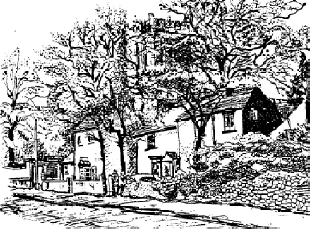



Amblecote appears in the Domesday Book as Am-bel-coit, or Elme-le-cote the exact meaning of which is unclear but could possibly refer to the wooded or rural nature of the area. It lay on the South Western fringe of the Black Country and formed part of the Manor of Enville (Enfield), property of the Earls of Stamford and Warrington. Amblecote was only a tiny hamlet with an equally small population. In 1662 it had approximately 300 inhabitants; in 1812 this had grown to just over a thousand; by 1862 the figure had risen to just over two thousand and by the end of the nineteenth century the number had passed three thousand. In 1838 the hamlet was just a sprinkling of cottages along the turnpike together with some six gentlemen's mansions further away from the road. Its Parish Church was St. Mary's, Old Swinford, the Mother Church of Stourbridge as well as Amblecote, which was a two mile walk from Brettell Lane.

With the increasing population and growing importance of the area it was considered that Amblecote should have a church of its own, and in 1838 the Lord of the Manor was approached with a request that he should assist the project. On February 20th, 1839 at a meeting in the Talbot Hotel, Stourbridge, a letter from The Earl of Stamford and Warrington (dated 20th December, 1838) offered two acres of land and £300 towards the erection of a Church in the hamlet of Amblecote together with an annual endowment of £100.
At a subsequent meeting held in the Public Offices, Stourbridge, on 23rd April, 1839 a committee of twelve was set up to see the project through its building stage. This group decided that the Church should be constructed from brick and faced with Fire-Brick, supplied at cost by William King of Amblecote Hall from his Withymoor works, which gives the building its distinctive old gold colour. The Church, which is a “Commissioners Church,” was designed in an Early English style by Samuel Hemming (or Heming) of Birmingham. By the beginning of July, 1839 the actual site had been agreed and subscriptions to the building fund now totalled £2,082.18s.0d. On 7th August, 1841 the first stone of the building was laid by James Foster Esq. and prayers were said by the Rector of Old Swinford, the Rev. C. H. Crauford. The Church was opened for divine service (at a total cost of £4,280.7s.8d. but not including the Iron Railings given by James Foster valued at £500) on Sunday, 7th August, 1842, and was Consecrated in November, 1844. It took until 30th June, 1849 to raise all the money and Amblecote became a separate parish in 1845. On October 28th, 1849 the Organ, built by J. Nicholson, was opened and an Organist appointed. Three years later the Clock was placed in the Tower. In 1856 the East Window was installed in memory of James Foster, the cost met by his former employees at John Bradley & Co. Iron Works and by friends. Mr. Foster was the largest contributor to the subscription list for the building of the Church.
A Commissioners' church, also known as a Waterloo church and Million Act church, is an Anglican church in the United Kingdom built with money voted by Parliament as a result of the Church Building Acts of 1818 and 1824. The 1818 Act supplied a grant of money and established the Church Building Commission to direct its use, and in 1824 made a further grant of money. In addition to paying for the building of churches, the Commission had powers to divide and subdivide parishes, and to provide endowments. The Commission continued to function as a separate body until the end of 1856, when it was absorbed into the Ecclesiastical Commission. In some cases the Commissioners provided the full cost of the new church; in other cases they provided a partial grant and the balance was raised locally. In total 612 new churches were provided, mainly in expanding industrial towns and cities.
© Geoff Warburton used by permission




